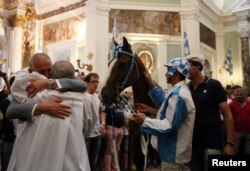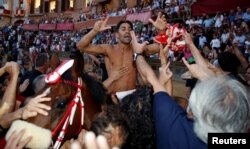The sounds of thundering hooves and a roaring crowd have filled Siena's Piazza del Campo almost every year since the mid-1600s.
The passion that surrounds the bareback horse race between riders from competing city districts — the Palio di Siena — is palpable to the point of sometimes being violent.
The race, held twice a year in July and August, is contested by 10 riders, each representing one of the city's 17 contrade, or parishes, racing around a makeshift earth track in the square.
The lure of local glory means that the rivalries between riders and fans is fierce.
Violence between rival supporters is not unknown but, for the winning jockey and his contradaioli, or parish members, a win is a cause for major celebration.
"When you win the Palio, inside the parish there's an explosion of joy and madness which is something incredible, all the contradaioli standing in the street, singing and crying," said Massimo Castagnini, an official with Onda parish.
With the three-lap race lasting around only 90 seconds, the rest of the day is filled with pomp and pageantry. It features an elaborate parade and ceremony, with members of each of the contrade in medieval garb, toting flags and coats of arms.
"The day of the Palio, there's really a big tension, the time goes too slowly for us," said Castagnini. "You just want to go in the square, stay with your people and thinking that will be the right time for your victory."
If victory is beyond a rider's grasp, the next best thing is preventing a rival from winning — and to that end, almost anything, including punching and kicking other riders, is permitted.
This year's race, run on Wednesday afternoon, was won by Carlo Sanna of the Onda parish, who was carried on the shoulders of supporters after his victory.
The race began after a local aristocrat banned bullfighting in 1590. It was replaced with buffalo races, before the first race of Palio races was held in mid-1600s.
With riders frequently thrown from their horses, and horses regularly suffering serious injuries, animal rights groups have called for the race to be banned. Around 50 horses died in the event between 1970 and 2015, according to Italy's Anti-Vivisection League, an animal rights group.
However, change appears unlikely anytime soon, as the race is tightly woven into the city's cultural and social fabric.
"It's not just the race," said Castagnini. "When you are born in a contrada, your people will take you from baptism till the end of your days."









